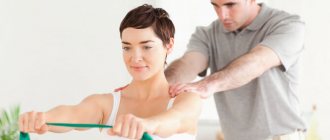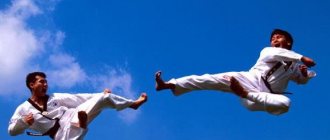Autogenic training (AT) is one of the methods of medical rehabilitation, including therapeutic self-hypnosis, self-knowledge, neurosomatic training, sedative and activating psychotraining, carried out under conditions of muscle relaxation and leading to self-education and mental self-regulation of the body. The main goals of the AT method are mastering the skills of self-management of the internal mechanisms of human life, training these mechanisms and increasing the possibility of their correction.
First autogenic training exercise
The goal of the first standard exercise is to develop the ability to relax the body.
1. I am calm... my right hand is heavy... Duration 30-40 seconds. Repeat for several days.
2. I am calm... my right hand is heavy...
I am calm... my left hand is heavy... my hands are heavy...
Duration 30-40 seconds. Repeat for 2-3 days.
3. I am calm... my right hand is heavy... I am calm... my left hand is heavy...
I am calm... my left leg is heavy... my right leg is heavy...
Duration 30-40 seconds. Repeat for 2-3 days.
4. I am calm... my left leg is heavy... I am calm... my right leg is heavy... Duration 30-40 seconds. Repeat for 2-3 days.
5. I am calm... my right leg is heavy... I am calm... my left leg is heavy... My legs are heavy...
Duration 60 seconds. Repeat for 4-5 days.
6. I am calm... my right leg is heavy... I am calm... my left leg is heavy... My legs are heavy...
I am calm... my right hand is heavy... I am calm... my left hand is heavy... My hands are heavy... My body is heavy...
Duration 60 seconds. Repeat for 4-5 days.
Second autogenic training exercise
The purpose of the second standard exercise is to increase the degree of relaxation and dilate the peripheral blood vessels. It is known that when the temperature rises, peripheral blood vessels dilate. This can be achieved by instilling in oneself the idea of warming the body.
1. I am calm... my arms and legs are heavy... Duration 60 seconds. Repeat for 9-10 days.
After this, the duration increases to 75-90 seconds, and the exercise is repeated for several more days.
2. I am calm... my arms and legs are heavy... My legs are warm... My right hand is warm... Duration 3 minutes. Repeat for 6-7 days.
3. I am calm... my arms and legs are heavy...
My feet are warm... my right hand is warm... my left hand is warm...
Duration 3 minutes. Repeat for 4-5 days.
4. I am calm... my arms and legs are very heavy... My legs are warm... my hands are warm... Duration 3 minutes. Repeat for 4-5 days.
5. I am calm... my arms and legs are heavy... My arms and legs are warm... My body is warm and heavy...
Duration 3 minutes. Repeat for 4-5 days.
Indications for autogenous therapy
Main indications:
- peripheral circulatory disorders, hypertensive arterial syndrome, initial stages of hypertension, arterial hypotension and other asthenovegetative states;
- angina pectoris, functional neurogenic arrhythmias;
- bronchial asthma, chronic pneumonia, psychogenic dyspnea;
- spastic conditions of the gastrointestinal tract, gastralgia, dyskinesia, colitis;
- vasomotor disorders of cerebral circulation, migraine, Meniere's syndrome, disorders of attention and memory;
- emotional disorders, sleep disorders, logoneurosis, cystalgia, alcoholism, mobilization of the psychophysiological state in athletes before and during competitions, neurosis-like and cerebrospastic syndromes in children.
Contraindications:
- the same as for exercise therapy;
- acute somatic and vegetative crises, GBP1;
- acute respiratory disorders (cough, dyspnea);
- acute neurological diseases accompanied by convulsive syndromes and disturbances of consciousness;
- decreased intelligence and memory; - age up to 12 years;
- hyperacid gastritis.
Depending on the characteristics of the individual, the severity and form of the organic or functional syndrome, the AT technique, autogenous therapy and its individual techniques must be strictly individualized. Failure to comply with this condition may reduce the expected effect or cause complications.
Third exercise of autogenic training
The purpose of the third exercise is to equalize the heart rhythm and calm cardiac activity. In a lying position, the practitioner places his right hand on the heart area and mentally pronounces the following autosuggestive phrase:
I am calm... my arms and legs are heavy... my arms and legs are warm... my heart beats calmly and rhythmically...
ALSO SEE: Take a hit: techniques for psychological defense against negative emotions
Duration 90-100 seconds. Repeat for 10-12 days.
KEEPING A DIARY
Journaling isn't everyone's cup of tea, but it has many benefits for us. When course participants keep a detailed protocol, the doctor can draw important conclusions from the notes about daily sensations and experiences. This is especially necessary when problems occur or when results take a long time to arrive. In addition, keeping a diary certainly has educational value. Some listeners are rightfully proud of their diaries, which they subsequently re-read like family albums.
Here is one example of a diary kept by a 33-year-old social worker:
1st day. During the first hour of training, I felt a heaviness in my right hand only after suggestion from the leader, but I did not feel anything during independent training. Lying down in the evening: slight feeling of heaviness.
2nd day. In the morning I did the exercise while lying down. I have difficulty concentrating, the birds singing disturbs me. After lunch: I tried to exercise at work, but nothing worked. Lying down in the evening: a slight feeling of heaviness, fell asleep surprisingly quickly.
5th day. Lying in the morning: nothing happens, there are too many thoughts in my head. I can’t abstract myself and concentrate. After lunch in the car: I worked on the road, on the way back from K. I stopped on the side of the road and started doing the exercise. Immediately there was a heaviness in my arm, and then in my leg. I experienced great joy! Passing cars did not bother me. There was hope. Lying in the evening: a completely clear feeling of heaviness in the right arm and a slight tingling sensation, but the leg does not feel anything.
7th day. When suggested by the course leader, I clearly feel heaviness and warmth. On the second attempt without the participation of a supervisor, there is again a slight feeling of heaviness and a slight tingling sensation in the right hand.
10th day. Lying down in the morning: I finally felt heaviness in the morning. The chirping of sparrows hardly bothers me anymore. At work: I feel heaviness, but only slightly warm. However, calm sets in and I feel fresh and rested. Lying down in the evening: heaviness and tingling in the right arm. I instantly fell asleep again.
Day 14 In class, the first exercise turns out great, but I can’t concentrate on the second because personal experiences get in the way. Lying down in the evening I was able to gather myself again, I even felt my heart slightly.
20th day. The mornings are the hardest for me, but this makes this training all the more important to me. At work, I now constantly achieve a state of calm, feeling heaviness and warmth. When I lie down in the evening, I always fall asleep instantly. Generalization occurs during each evening workout.
Day 28 When suggested from the outside, I felt a wave of warmth throughout my whole body and was so happy that I could not concentrate on the breathing exercise. While training on my own, I also felt intense warmth.
Day 42. I should feel like an exemplary student. Again I mastered the new exercise straight away. However, a wave of heat covers the entire body only with outside suggestion. Self-training does not give such a clear effect.
Day 50 I was able to do the exercises in the morning. Improvement across the board. Auto-training in the morning is a good basis for the whole day. When training during the day, the sensations of heaviness and warmth arise reflexively, I don’t even have to concentrate. In the evening, as usual, I fall asleep very quickly during training.
Day 63 I didn’t train in the morning, because I urgently needed to go to a meeting in D. There, at lunchtime, I trained in the meeting room. Generalization did not occur immediately, but in the end everything worked out. In the evening during classes: with suggestion from the outside, I immediately felt a “breath of ghosts,” but with independent training, not yet. As a goal formula, I now use the usual phrase: “I am absolutely calm and relaxed.” It is always good for me, although I have already become much calmer, although only outside the house for now.
70th day. I finished the course today. This is very valuable to me. Now I won’t give up auto-training. For me, morning and afternoon workouts are more important than evening workouts because I fall asleep too quickly. Maybe a new formula will help me: “I am alert during training.” If this doesn’t help, I’ll try the “completely alert” formula.
Day 84: In the morning, as usual, everything worked out. There is peace, heaviness and warmth throughout the body. At work I have certainly become calmer and more balanced than before, but at home, unfortunately, this is not always the case. Successfully completed an afternoon training session during a meeting break. Lying down in the evening: the formula “during training I am alert” is enough for me. In the evening I have repeatedly experienced the feeling as if my hands were floating freely in the void. Day 99 Overall, as a result of auto-training, I feel much better. I just have to say “Calm” to myself and I immediately calm down. I constantly note successes at work during unexpected situations and in conversations with aggressive clients. But in family life I notice how difficult it is to remain calm in any situation. I will send my wife to the next courses, and I will be with my child. We really should have gone together, as the doctor recommended. If today, after three months of training, I try to evaluate how auto-training affected me, then I would say that the formula “I am completely calm and relaxed” is carried out literally. Family life became better, and sleep became a pleasure. I am committed to continuing my regular training.”
In the chapter on discharge and accompanying phenomena I will give excerpts from other diaries.
The fourth exercise of autogenic training
The fourth standard exercise makes the breathing process its object. Note that the first three standard exercises, although indirectly, also affect the breathing process, calming and harmonizing it. The purpose of this exercise is to directly influence the respiratory rhythm. The following autosuggestive phrase is used:
I am calm... my arms and legs are heavy and warm...
My heart beats calmly and rhythmically...
I breathe deeply and evenly...
Duration 2 minutes. Repeat for 15-16 days.
Complications
The most common complications:
- maintaining a feeling of heaviness after an AT session, delayed recovery from autogenic or hypnotic immersion;
- decreased general tone of the body, increased hypotension, asthenia, apathy (in the case of using relaxing techniques instead of mobilizing ones);
- decreased level of wakefulness;
- a feeling of “lethargy”, “vatness” of the muscles, leading to a decrease in performance, loss of “shape” in athletes;
- vasomotor disorders (fainting, headache, migraine, etc.) with improper use of standard exercises 5, 6, etc.
To prevent complications and to strictly individualize the use of AT and autogenous therapy methods in clinical practice, strict monitoring and registration of psychovasotonic, psychoneurotonic and psycho-myotonic effects is necessary.
Programs of psychohygienic and psychoprophylactic measures are implemented in psychological relief rooms (PRO).
The main factors used in the CRC:
- sanitary and hygienic (comfortable microclimatic conditions, optimal air-gas composition, visual and acoustic comfort);
- physiological (oxygen-vitamin cocktail, comfortable relaxing posture, regulated breathing, posture-tonic exercises, etc.);
- psychophysiological (exposure to light, color, rhythm, music, interior, smell, etc.);
- physiotherapeutic (self-massage, hydroaeronization, exposure to phytoncides, etc.);
- psychohygienic (AT, psychophysical gymnastics, neurostimulating training, suggestion, rational psychotherapy, consultations, conversations, etc.).
Fifth exercise of autogenic training
Physiological and psychotherapeutic studies have shown that warming the abdominal area calms the activity of the central nervous system. Therefore, the goal of the fifth standard exercise is to achieve this effect. The following autosuggestive phrase is used:
I am calm... my arms and legs are heavy and warm...
My heart beats calmly and rhythmically... I breathe deeply and evenly...
My solar plexus radiates warmth...
Duration 3 minutes. Repeat for 20 days.
Contraindications
You should not engage in auto-training during the acute stages of the disease; it is better to start relaxing during remission. In addition, with unclear consciousness or vegetative crises, a person’s condition may worsen after autogenic exercises. Acute somatic attacks and delirium are contraindications for training. Automotive training sessions are recommended when a person is emotionally exhausted (stress, fears, depression), since many painful conditions of the body are the result of a weakened nervous system.
Sixth exercise of autogenic training
It has long been known that cooling the forehead using a compress or other means leads to results favorable for nervous activity. This is the purpose of the sixth standard exercise. The following autosuggestive phrase is used:
I am calm... my arms and legs are heavy and warm...
My heart beats calmly and evenly... I breathe deeply and evenly...
My solar plexus radiates warmth...
My forehead is cool...
Duration 2 minutes. Repeat for 15 days.
***
Autogenic training according to Schultz originally arose for use in medical practice as a psychotherapeutic means for treating sick people in a clinical setting. This technique can also be used by healthy people seeking to expand their mental and physical capabilities.
One of the important merits of Johannes Heinrich Schulz was that he used the experience of some yogic systems accumulated over centuries, clearing them of their inherent mysticism. The school he created, through its many years of clinical practice, confirmed the effectiveness of autogenic training as a means of treatment and self-development.
Autogenic training has established itself as an effective psychotherapeutic tool that is increasingly replacing hypnosis. In our opinion, the benefits of autogenic training are as follows:
- With hypnotherapy, the patient is passive towards treatment, while with autogenic training, he performs purposeful volitional activity.
- In hypnotherapy, the personality of the attending physician dominates the personality of the patient.
- Hypnotherapy is not suitable for patients with a low degree of suggestibility.
You can study the full methods of autogenic training, psychosomatic reactions and symptoms in the “Valeology” course: separately or by subscription at a discount.
Explore today
Dissection cadaver course on injection techniques in cosmetology. Day three: live injections
Developing self-confidence
Dissection cadaver course on injection and thread techniques in cosmetology. Day three: live injection master class
Project management
Psychology of Motivation and Influence
STERILIS: asepsis and antiseptics in the practice of a cosmetologist. Everything about the prevention of complications and secondary infections
Memory development
Introduction to Modern Marketing
Budgeting and intra-company planning
What does autogenic training give?
The main task that autogenic training can easily cope with is restoring the body’s strength and combating stress. This training is a synthesis of hypnosis with elements of yoga. Auto-training is aimed at restoring the dynamic balance of the body (the human homeostatic mechanism) by neutralizing stress and gaining calm. Autogenic training is similar to therapeutic hypnosis, but there are significant differences. It lies in the patient’s ability to actively and independently participate in the training process.
This psychotherapeutic technique brings benefits to the physical and moral state of a person. For auto-training to be effective, you need to pay attention to the following important factors:
- You can’t do without strong motivation and a desire to engage in autogenic exercises;
- self-control and the ability to self-regulate are important during training;
- body position during training should be comfortable and correct;
- full concentration of consciousness on internal sensations, minimizing the influence of external factors.
To calm the nervous system
The body suffers daily from stress and constant feelings of anxiety, depression, and fatigue. Schultz's auto-training is designed to teach the body to calmly and adequately respond to external stimuli. Relaxation of consciousness and forced relaxation through auto-training have a positive effect on the body and allow you to learn to calmly react to problematic situations that arise. Thanks to regular autogenic exercises, a person can learn to minimize outbursts of negative emotions.
Physiological effect
With the help of auto-training, you can learn to regulate the body’s heartbeat, breathing rhythm and level of muscle tension. Cholesterol levels after training in an autogenic state are significantly reduced. It is good to use this psychotherapeutic technique for people suffering from insomnia, high blood pressure and frequent migraines. When the mind relaxes during autogenic exercises, the activity of alpha waves increases, which has a beneficial effect on various body systems and helps fight diseases (diabetes, tuberculosis, cancer).









